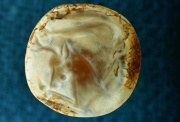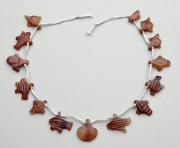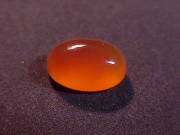Difference between revisions of "Carnelian"
Jump to navigation
Jump to search
| Line 10: | Line 10: | ||
== Physical and Chemical Properties == | == Physical and Chemical Properties == | ||
| − | * | + | * No visible crystals |
| − | * Fracture = conchoidal | + | * Fracture = conchoidal, uneven, splintery |
| − | * Luster = vitreous | + | * Luster = waxy to vitreous |
| − | * Streak = white | + | * Streak = white |
| + | * Fluorescence = generally inert | ||
| + | * Pleochroism = absent | ||
{| class="wikitable" | {| class="wikitable" | ||
| Line 21: | Line 23: | ||
|- | |- | ||
! scope="row"| Mohs Hardness | ! scope="row"| Mohs Hardness | ||
| − | | 7.0 | + | | 6.5-7.0 |
|- | |- | ||
! scope="row"| Density | ! scope="row"| Density | ||
| − | | 2. | + | | 2.59-2.61 g/ml |
| + | |- | ||
| + | ! scope="row"| Refractive index | ||
| + | | 1.535 - 1.539 | ||
| + | |- | ||
| + | ! scope="row"| Birefringence | ||
| + | | undetectable to 0.04 | ||
|} | |} | ||
| Line 34: | Line 42: | ||
* Mineralogy Database: [http://www.webmineral.com/data/Quartz.shtml Quartz] | * Mineralogy Database: [http://www.webmineral.com/data/Quartz.shtml Quartz] | ||
* ''Encyclopedia Britannica'', http://www.britannica.com Comment: "carnelian." Accessed 14 Sept. 2001 . | * ''Encyclopedia Britannica'', http://www.britannica.com Comment: "carnelian." Accessed 14 Sept. 2001 . | ||
| − | + | * Gem Identification Lab Manual, Gemological Institute of America, 2016. | |
* C.W.Chesterman, K.E.Lowe, ''Audubon Society Field Guide to North American Rocks and Minerals'', Alfred A. Knopf, New York, 1979 | * C.W.Chesterman, K.E.Lowe, ''Audubon Society Field Guide to North American Rocks and Minerals'', Alfred A. Knopf, New York, 1979 | ||
| − | + | * Wikipedia: [https://en.wikipedia.org/wiki/Carnelian Carnelian] (Accessed Sept. 14, 2005 and Dec 2022) | |
| − | * Wikipedia: | ||
[[Category:Materials database]] | [[Category:Materials database]] | ||
Revision as of 12:03, 19 December 2022
Description
A pale orange-red to deep red translucent stone that is a variety of Chalcedony. Carnelian was mined or gathered as an ornamental stone since at least 3000 BCE. It is found in Egypt, India and areas of Europe as water-worn pebbles. Carnelian was popular for amulets and scarabs and is still used as gemstones.
Synonyms and Related Terms
sard; cornelian; chalcedony; Karneol (Deut., Pol.); cornaline (Fr.); cornalina (Esp., Port.)
Physical and Chemical Properties
- No visible crystals
- Fracture = conchoidal, uneven, splintery
- Luster = waxy to vitreous
- Streak = white
- Fluorescence = generally inert
- Pleochroism = absent
| Composition | SiO2 |
|---|---|
| Mohs Hardness | 6.5-7.0 |
| Density | 2.59-2.61 g/ml |
| Refractive index | 1.535 - 1.539 |
| Birefringence | undetectable to 0.04 |
Comparisons
Properties of Common Gemstones
Resources and Citations
- Mineralogy Database: Quartz
- Encyclopedia Britannica, http://www.britannica.com Comment: "carnelian." Accessed 14 Sept. 2001 .
- Gem Identification Lab Manual, Gemological Institute of America, 2016.
- C.W.Chesterman, K.E.Lowe, Audubon Society Field Guide to North American Rocks and Minerals, Alfred A. Knopf, New York, 1979
- Wikipedia: Carnelian (Accessed Sept. 14, 2005 and Dec 2022)


